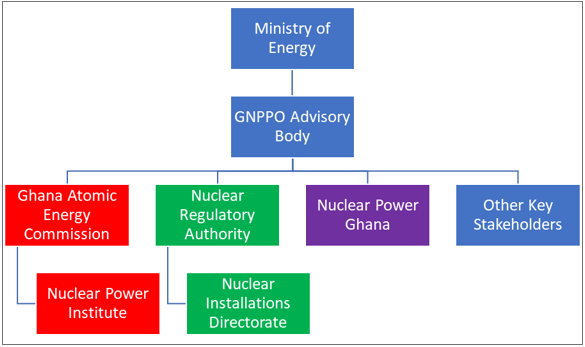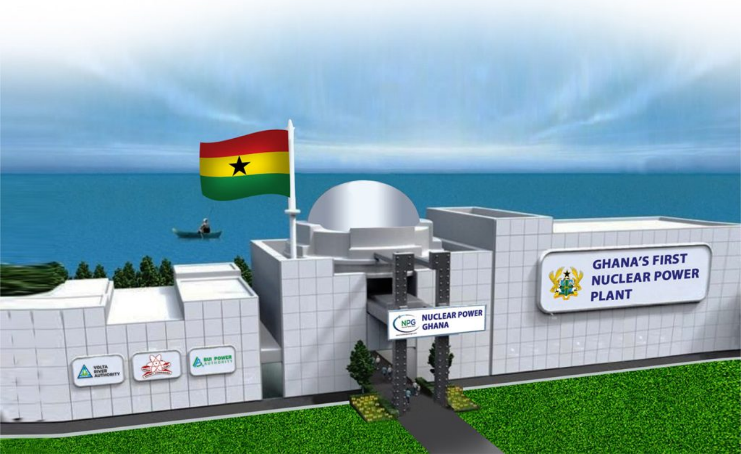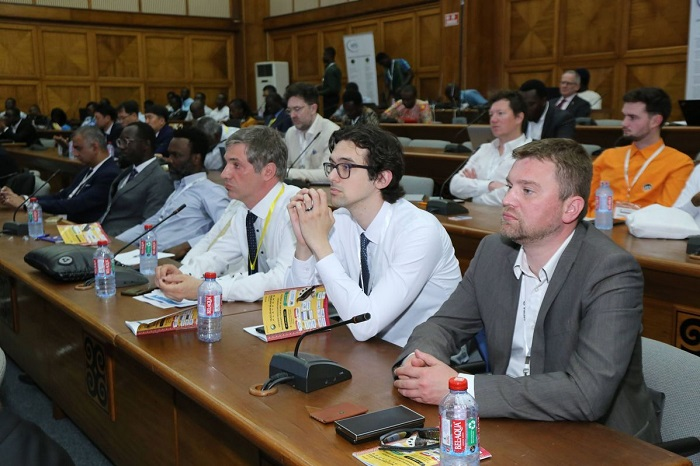Ghana’s relentless pursuit of nuclear power
M. Mbems
January 10, 2025
G hana's nuclear ambition started in the early 1960s. Since independence, successive governments have argued that nuclear energy can diversify electricity supply and boost economic development. In 1961, the government launched the Kwabenya Nuclear Reactor Project to produce electricity. The government then set up the Ghana Atomic Energy Committee to implement the Kwabenya Nuclear Reactor Project. This committee later became the Ghana Atomic Energy Commission (GAEC) through an Act of Parliament in 1963. Soon after, Ghana and the Soviet Union started work on the construction of a 2MW reactor. But, for over the past 50 years, the program stalled. Since 2006, the increase in electricity demand has rekindled interest and instilled a new new momentum.
The Ministry of Energy and the Ghana Atomic Energy Commission (GAEC) forecast that the first plant will be operational by 2030. But this is only achievable if they can complete technical studies and also if they can meet compliance standards, including safety and environmental impact assessment. The must also develop a viable and sustainable financing model for the project. That northwithstanding, the authorities have announced that the first plant will have a generation capacity of 2,400 megawatts (MW). This corresponds to an increase of 50 percent of current national electricity production. The plans will cost between US$5.00 and US$6.00 billion to build.
Institutional development
Although Ghana’s nuclear ambition has remained elusive so far, the authorities have continued to develop institutions and build partnership. Since 2018, the interim goal is to meet the standards of the International Atomic Energy Agency (IAEA) in terms of safety, skills and manpower.
Under the Ministry of Energy, the Ghana Nuclear Power Program Organisation (GNPPO) coordinates technical issues related to the infrastructure that will underpin the project. In 2019, the government identified 19 infrastructures that are vital for the country’s nuclear ambitions. They include, amongst other items, selected and developed sites, reactor, steam generators and cooling towers.
In the current institutional setup, the GNPPO relies on the Nuclear Power Institute (NPI) for important technical issues. This institute has five Technical Centers, each responsible for specific infrastructure issues1. The Nuclear Regulatory Authority has a broad mandate, including the power to regulate the civilian use of nuclear and other radioactive sources. It has training institutions, research institutes, and laboratories.
Nuclear project: Institutional setup

Source: GNPPO and NPG
In 2019, the government registered the Nuclear Power Ghana (NPG) LLC, a public company, as the owner and operator of Ghana’s future first nuclear plant2. The company has outlined plans to work with the IAEA and domestic public institutions to achieve its goals. The Nuclear Power Ghana (NPG) has two shareholders, the Volta River Authority and the Bui Power Authority.
Domestic and International partnership
Ghana has also increased cooperation with the IAEA since 2018. Besides training, Ghana received seismic equipment through cost sharing with the IAEA. In a 2019 evaluation, the IAEA declared that ‟the country’s nuclear power program is being developed in line with the IAEA framework”3. The IAEA is also assisting Ghana with the development of procedures related to site evaluation and selection.
Another international partnership involves the European Union. Since 2019, the Nuclear Regulatory Authority receives technical training from the ‟European Union’s Instrument for Nuclear Safety” to develop a regulatory framework. Ghana is also receiving capacity building from Japan, China, the United States, Canada and Russia.
Moreover, in September 2017, the NRA agreed on an information exchange and cooperation in nuclear safety matters with the US Nuclear Regulatory Commission (NRC). In September 2019, the NRA also signed a memorandum of understanding with the Canadian Nuclear Safety Commission (CNSC) and then with the Pakistan Nuclear Regulatory Authority in December 2021. The NRA discussed Memorandum of Understanding (MoUs) with Rostechnadzor of Russia and AMSSNUR of Morocco during the same period.
Vision: A model nuclear plant

Source: GNPPO and NPG
Vendors: China, the United States or Russia?
In June 2021, Ghana issued a Request for Information (RFI) to vendors for the construction of its nuclear power plant. Ghana targeted six countries: China, India, Russia, the USA, South Korea, and France. The Nuclear Power Ghana (NPG) LLC crafted the RFI to gather technical expertise and financial insights. In September 2021, the government announced that vendors from the US, Russia, Canada, China, and South Korea had responded to the RFI. The company also revealed that the RFI yielded a wealth of technical data, including fifteen different technologies proposals from the vendors. For example, the size of the reactors proposed by the vendors ranged from 700MWe to 1400MWe for large reactors and 50MWe to 300MWe for small modular reactors4.
China
In April 2024, Ghana signed a framework agreement with the China National Nuclear Corporation (CNNC) to construct an HPR-1000 (Hualong One) nuclear power plant and upgrade its electrical grid. The Hualong One is a Chinese Generation III pressurized water nuclear reactor developed by the China General Nuclear Power Group (CGN) and the China National Nuclear Corporation (CNNC). Hualong One was first put into commercial operation in China in January 2021. On April 2023, Ghanaians authorities issued a statement. This statement announced ‟a cooperation and framework agreement for the construction of a HPR-1000 (Hualong One) Nuclear Power Project and the upgrade of Ghana’s grid”. This agreement is neither a contract nor a definite commitment. However, the CNNC President Yu Jianfeng was optimistic. After the signing, he told the media that ‟this agreement will yield fruits”5.
USA
In May 2024, the U.S. and Ghana signed a ‟Memorandum of Understanding and Contractual Arrangements” for the provision of the NuScale Energy Exploration (E2) Center and related services at the Ghana Atomic Energy Commission (GAEC). The E2 Center will serve as a training hub for future nuclear operators and engineers for Small Modular Reactor (SMR) technology.
Ghana solidified the exchanges with a memorandum of understanding with Regnum Technology Group, an American company, to deploy a single NuScale VOYGR-12. This small modular reactor plant has the capacity to produce clean and reliable electricity. SMR can adjust electricity output to match demand. They are flexible enough to pair with renewable generation, and can benefit markets beyond electricity. The US Department of Energy backed the move, adding that ‟SMR offers flexibility in power, size, and operations especially in urban and remote settings”.
The two parties made the announcement during the Africa Nuclear Business Platform meeting in Accra, Ghana on May 28 2024. Officials from the US Department of Energy announced that Regnum Technology Group and GNC llc ‟plan to form a subsidiary company”. This Ghana-based subsidiary will own and operate the country's commercial SMR plant6.
Russia
According to the UK based environmental group, Climate Compatible Growth (CCG), Rosatom stands out amongst the bidders. The CCG says that Rosatom (a Russian state corporation) possesses ‟the complete nuclear supply chain and expertise” to build a nuclear power plant in Ghana7.
During the 2024 Africa Nuclear Business Platform that took place from 28th to 31st of May 2024 in Accra, Rosatom presented the concepts of ‟small land-based and floating nuclear power plants (FNPP)”. Rosatom said that it will offer a modern solution for sustainable and efficient energy production. The company stressed its global technological and multi-industry holding comprising assets in power engineering, machine engineering, and construction, among others.
Rosatom is conglomerate of over 400 enterprises and is one of the world leaders in the nuclear energy industry. The company is the world’s second-largest owner uranium reserves, the fifth-largest uranium producer and nuclear energy. It controls 40 percent of the world market of uranium enrichment services and 16.3 percent of the nuclear fuel market.
Rastom Team in Accra, 2024

Source: Rosatom
Next Steps
Ghana must overcome financial and technical challenges before it turns on its first nuclear plant. Ghana is on a recovery path after five years of economic turbulence. The country defaulted on its domestic and international debt in December 2022. This is one of the negative consequences of the COVID-19 pandemic, which brought the economy to a stand still from February 2020. Ghana signed an economic reform program; a three-year Extended Credit Facility agreement (ECF - 2023-2026) with the International Monetary Fund in May 2023. The ECF is helping Ghana recover from fiscal vulnerabilities, unsustainable public debt, high inflation, depreciating currency and to tackle other lingering consequences of the Covid-19 pandemic.
This economic context creates financing constraints and risks for the nuclear project.However it has not diminished the interest of Ghana's vendors. In fact, the five country vendors have ‟expressed willingness to provide loans covering up to 85 percent of the total project cost‟8. According to information received by New Economy Ghana , some vendors have held exploratory talks with their respective national Export Credit Agency (ECA)and syndicates of private lenders and engineering companies, who have expressed interest in teaming up to develop a financing mechanism for the nuclear plant. Officials in Ghana are aware that any financing option will involve debt (and/or equity) or other forms of structured finance. This financing structure will create long-term financial liabilities for Ghana. The cost of the loan will depend on the overall creditworthiness of Ghana after the country exits the ECF.
The authorities also acknowled that they will have to overcome other market and technical challenges. Over the past two decades, Ghana has restructured its electricity sub-sector, separating production, transmission, and distribution. A bankable financing model for a nuclear plant will require a power purchase agreement (ppa) between Nuclear Power Ghana (NPG) LLC and the national distributor: the Electricity Company of Ghana (ECG). This means that the solvability of the ECG and its ability to pay for the electricity supplied by the NPG will be a part of the financing model of lenders. The predictability of this cash flow is essential for the long-term viability of the project. The ECG is currently saddled with debt and is going through a significant debt restructuring process in the context of the ECF. But the good news is that the NPG LLC does not have to sell its electricity only to the national distributor. The West African Electricity Power Pool (WAPP)9 offers immense opportunities and Ghana has decades of experience in exporting electricity to its neighbors (Cote d’Ivoire, Togo, and Burkina Faso).
Also, the IAEA recommends an optimal equilibrium in the national energy mix of its members. Specifically for Ghana, the institution recommends a net increase in electricity production before the nuclear plant becomes operational. The IAEA recommends that Ghana keeps the nuclear reactor generation capacity under 10 percent of the national generation capacity. The government has outlined a multi-year plan to increase generation capacity to 10,000 MW by 2030 (from 5500 MW today) in line the IAEA recommendation.
Related Articles
BIBLIOGRAPHY
1❩ Benjamin. J. B. Nyarko (2018): Ghana Nuclear Power Programme Organisation: Responsibilities and Challenges https://inis.iaea.org/collection/NCLCollectionStore/_Public/51/090/51090138.pdf
2❩ Nuclear Business Platform (Sep 26): Ghana Inks Multiple Agreements With Key Nuclear Countries In 2024 - https://www.nuclearbusiness-platform.com/media/insights/ghana-inks-multiple-agreements-with-key-nuclear-countries-in-2024
3❩ IAEA (2022): National report on compliance with the convention on nuclear safety obligations (8th and 9th review meeting of the convention on nuclear safety) - https://www.iaea.org/sites/default/files/24/02/cns_report_2022_ghana.pdf
4 ❩ Michael Creg Afful (2021): Ghana’s NPG reviews RFI responses from six vendor countries for its nuclear power plant project - https://energynewsafrica.com/ghanas-npg-reviews-rfi-responses-from-six-vendor-countries-for-its-nuclear-power-plant-project/
5❩ GAEC (April 2024): Ghana and China to co-operate on HPR 1000 nuclear project - https://gaec.gov.gh/ghana-and-china-to-co-operate-on-hpr-1000-nuclear-project/
6❩ US Department of Energy (2024): Commercial SMR Agreement Reached at U.S-Africa Nuclear Energy Summit. - Africa Nuclear Energy Summit - https://www.energy.gov/ne/articles/commercial-smr-agreement-reached-us-africa-nuclear-energy-summit#:~:text=During%20the%20summit%2C%20Ghana%20nuclear,nuclear%20energy%20across%20the%20continent.%E2%80%9D
7❩ https://climatecompatiblegrowth.com/wp-content/uploads/Ghana-Nuclear-Policy-Brief_20240917.pdf
8 ❩ CCG ibid
9❩ The West African Power Pool (WAPP), consisting of 14 interconnected power systems, offers a platform for balancing electricity supply and demand through cross-border transfers.
